Transporting a car.
If you are asking yourself "how do I move this car?", "who will collect this for me?" or "how can I tow it home?" then perhaps this article on transporting a car will give you some food for thought...
"Normal" people go to a shiny dealership, and pay through the nose for a
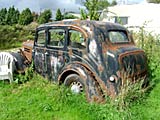 |
| Moving an old car like this one would take great care, and definitely requires the use of a trailer or recovery lorry. A shovel might not go amiss either.. |
dull and usually fairly boring modern car. But if you've made it to this page, there's an excellent chance that you don't fit this description of "normality". No, you've decided to buy a car (van, pickup, truck or whatever) at the other end of the country, that probably doesn't run, may have no MOT, and quite possibly little chance of actually running without major mechanical overhaul, and possibly spiritual intervention. For the sake of this article, let's group ourselves under the name of The Optimists. What follows is based on my own experiences combined with tips gleaned from people I've known, but is not a comprehensive guide to moving vehicles. If you have any doubts about moving a car yourself, get someone who knows what they're doing to do it.
Once you've decided on this wise purchase, there comes the issue of how to move this car. We Optimists don't usually dwell on matters like transportation or storage of a new classic prior to purchase, that kind of thing is for the more rational amongst us. Nope, we decide to buy something, and then give a little thought to these hurdles. Serial buyers may well have all the equipment in place to drop everything, and shoot off in the dead of night to go and collect their new vehicle, but what if you've not had to move or collect a car before? What are some of the things you need to consider when moving a car? Hopefully this page will shed some light on things to think about.
Your approach to collecting the car will depend very heavily on its condition. Is it MOTd? does it run at all? or has it sat in a ditch for the last 20 years with junk piled around it and a tree growing through the chassis? The more information you have to hand when planning the move, the better. I'll mention it here as it can easily catch you out - check whether the car comes with a pile of spare parts, and if so, find out exactly what they are. If the spares add up to a bucket-full of condensers, spark plugs, and door handles then you've no problems with carting them back with the car. But if the spares are heavy items, like axles and engines, or just bulky, such as seats and outer bodywork panels, then you will need to bear this in mind when planning to move the car. The distances involved will also have a major influence on how you plan the operation.
Drive your new classic car home.
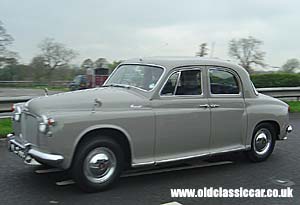 |
| It's usually more fun and cheaper to move a car by driving it, rather than using a trailer or recovery firm. |
Let's get the easy option out of the way first. The car is MOT'd and has been in recent regular use. You could therefore consider driving it home, although if it's only done local hops in recent years, your plan to drive it from Inverness to Exeter in one go could overly strain it a little, and you may well be better planning the move as you would for a non-running car. However if the car seems to run well, and the journey isn't too lengthy, why not give it a go and drive it home? it'll save on transportation costs, and probably be an enjoyable drive. Points to remember though if you do plan to move your car this way:
- Do you know how to drive this type of car already? some older cars can be very "quirky".
- Arrange insurance before you go for the car - don't rely on the current owner still having insurance on it, allowing you to drive it third party on your regular policy.
- Take tools and vital fluids - not just for the car, but for you too, and check them all before setting off.
- Have a mobile phone and, in my opinion, breakdown recovery membership, to help if things go pear-shaped en-route home.
- Double-check that the MOT will still be valid when you go to collect.
- Plan your route to avoid unnecessary hold-ups, and schedule the trip to last during daylight hours wherever possible.
- Find out if the car has any eccentricities that you should gen up on, prior to collecting it.
- Try to have someone in a 'support car' following behind, to pick up anything that falls off, or help out if you break down. Don't forget to pick a suitable support car and driver, especially if there is a mountain of spare parts to drag home.
- Before setting off for home, ask how accurate the petrol gauge is, and establish whether there are any tricks required to open the fuel filler flap, or remove the cap.
Many of these pointers apply whichever method you use to collect the car.
Don't aim to set any speed records, and go for the simplest route without too much stop/start town driving involved. Even restored cars break down, so on your first journey together, it's better to choose the smoothest, least stressful journey, even if it may be slightly longer in mileage terms. If there is a choice of main or country roads, I'd go with the former - if you do run into difficulties, such as conking out at the side of the road, or running out of fuel thanks to an inaccurate fuel gauge, you'll be in a much better position to sort it if you have garages and other facilities nearby, than stuck in the middle of a puddle miles from anywhere. Should the worst happen and you need to call the breakdown people, they'll find you much more easily and quickly if you're on a popular road. Chances are the bigger roads will be lit up at night too, which could be a godsend if you have to do some en-route fettling to your cherished new motor. The KISS principle applies quite well here - Keep It Simple Stupid - make the trip as easy as possible, plan plan plan, and you'll stack the odds in your favour for a safe and straightforward mission.
Moving a car with a tow rope.
Of all the methods I'll touch on here, towing a car on a rope is my least favourite, and only one I'd fall back on if really desperate. My understanding (in the UK at least) is that the car being towed should be road legal, so something to bear in mind if your new 'buy' has been parked on blocks since WW2 (the kind of car that the Optimist will often fall for). The car being towed also has to have excellent brakes and fully-functioning steering.
 |
| Don't skimp if you decide to move your car home with a rope. |
The idea is that the driver being towed has to keep the rope taught, this can involve regular use of the brakes even when moving along, simply to keep the rope taught and minimise the jolting that can occur if the rope is allowed to slacken. The second car needs to be able to brake before the tow car when approaching junctions etc, to keep the rope taught. The rope needs to be of sufficient length to allow the pilot in the towed car to keep an eye on it at all times, so use a decent quality rope of suitable length, and not something pieced together from scraggy old bits. The second car should also have an 'On Tow' sign in the back, and a working set of lights at the rear too - either the car's own lighting, or else a lighting board powered by the tow car. If using the
car's own lights, it is wise to disconnect the coil as it'll overheat with the ignition being on for a lengthy period of time (usually necessary to have working indicators and brake lights). If using a light board, check that the lead is long enough to run from the tow car, to the back of the 2nd car. If it isn't, buy a lead extension from a caravan or trailer spares outlet, and route it carefully so that it doesn't rub against either car's paintwork, or the road.
Again, I'd say that towing with a rope is really only suitable for short tows, and I'd never put someone in the second car that wasn't happy to be there - they need to be on the ball constantly, or else you run a real risk of the towed car piling into the back of the tow car. Some rather unwise Optimists have tried to use the towing eyes fitted to more recent cars for dragging a car along, but they were never intended to be used like this. The rope should only be tied to a towbar on the towing car, and a sturdy chassis or suspension member on the car being towed - don't tie the rope to a steering arm as it'll rapidly take on the shape of a banana, the same goes for bumper bars. Pedestrians have the annoying habit of walking between cars while stopped at traffic lights, so to avoid them tripping over your rope and dropping their shopping, tie a bright piece of cloth to it.
Real consideration needs to be given to the tow-car, and the person who will be driving it. Are they both up to the task? If you've just bought a large Jaguar for instance, towing it behind a small or medium-sized car isn't really an option - you'll struggle with all but the slightest incline, and be a danger to those around you. The towcar's clutch (or automatic gearbox) may not be too impressed either by journey's end. Talking of Jaguars brings to mind something else you'll need to think about - if the second car is an automatic, you'll need to use a trailer or recovery lorry, as towing a non-running automatic with its driven wheels turning will probably damage the 'box.
Using an A-frame or towing dolly.
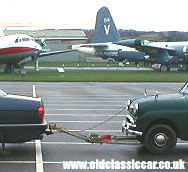 |
| Using an A-frame is often preferable to using a tow rope if recovering a vehicle. |
A more civilised approach to using a rope is to use an A-frame, or a towing dolly. The former attaches to the axle of the 2nd car, and provides a rigid tow (a towing bar would have a similar effect). A dolly incorporates a pair of wheeled buckets, into which the 2nd car's front wheels sit, suitable strapped in. Use of either can mean that no-one need sit in the towed car, although with the A-frame, the suspension geometry of the second car can affect how well the car will steer itself, and may need a pilot on board to control the steering. I've towed upright Ford sidevalves with an A-frame and the steering has worked correctly, whereas I tried it with a Standard 8 once and it wouldn't work unless someone sat in it. It'd be wise to double-check the legal side of things,
some people I've spoken to say that the second car must be road legal, as with using a rope, whereas others say this is not the case. Strictly speaking they should only really be used for emergency recovery jobs. Best to check with the local Constabulary if you have concerns. Whatever, the second car needs to be safe, all together and no risk to pedestrians (so no sharp edges, rusty bits sticking out, and so on!), and again lighting plus an 'On Tow' notice need to be in place. Check the tyres too, last thing you need is a puncture during the journey.
Trailering your prized new possession.
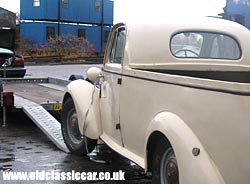 |
| If the car hasn't driven for some time, a quality trailer is the best option for moving it. |
If there are any question marks about the legality, reliability or anything else to do with the new car, I'd recommend using a trailer over the aforementioned methods of moving a car. Get a proper, well serviced, trailer of suitable size for the car being collected, and you don't have to worry about whether it's roadworthy, MOT'd, taxed or insured, as all four wheels are off the road. If the car doesn' t run, remember to get a trailer that has a winch!
Any old derelict can be collected on a trailer, just make sure that nothing can stick out to annoy nearby cyclists, or fall off and wind-up motorists who might be driving behind. Again a suitable towcar needs to be used (remember it'll be pulling the combined weight of the trailer plus the new car), and some practice at towing and reversing without a load is recommended if you've not tried towing a long trailer before. Here's a more detailed article on towing trailers at oldclassiccar if you want to find out more. Ideally the trailer should have its own braking system, and the combined weight of the second car and trailer should not be more than 75% of the towcar's weight, although regulations on this will no doubt change over time, and depend on which country you plan to do this in. If there are any loose parts to be brought back, tie them down well before setting off.
Professional recovery services.
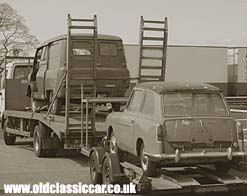 |
| Using a professional vehicle recovery outfit might be a good option, if your main car isn't up to towing, or if you have more than one car to drag back home. It could also be cheaper than making two separate trips yourself. |
If you're not keen on recovering a new acquisition yourself using the different approaches touched on here, your best bet may be to pay a professional transport outfit to do it for you. Make sure you fish around for a number of quotes, and that you know exactly what you'll be charged for. Some firms charge per mile both ways (ie there and back), whereas some just charge on the outbound trip. Also check that they have suitable insurance cover in case the worst happens, and if you can speak to people who've used this company before, do so.
The cheapest option may not be the best - I'd rather entrust one of my old motors to a firm operating a smart modern lorry, than a cheaper one that runs a twenty-year-old smoker with dodgy tyres and signs of crash damage. You pay your money etc etc. Recovery outfits may only be set up for collecting vehicles that roll and are easily accessible, so the Morris Oxford that is sat in the corner of a yard behind 300 rusty Fiats, may need dragging out before the recovery chap will collect it for you. He won't be too impressed if there are piles of oily old spares that need collecting either, and may refuse to bring them with the car, or else charge more for his time in loading and strapping them down to his wagon.
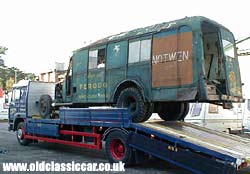 |
| When it was time to move my Dodge, the only option was a bigger lorry.. |
All of the above has been written with collecting an old car in mind, but much of it will also apply to small vans, pickups, and similar vehicles. If your passion is elderly lorries, professional recovery could well be your only option due to their bulk and weight. You'll need to know the weight and dimensions of the vehicle to be collected before getting quotes, as not all recovery firms can handle large commercial vehicles. Some classic lorries have large petrol engines, and it could work out cheaper to pay a transport firm to collect it, even if it is fully roadworthy, than drive it back drinking fuel at 4 or 5 mpg.
How to move a car - a summary.
If you feel up to it, are an Optimist, and have a suitable tow car, there's no reason why you can't move a classic car on your own, bearing in mind some of the points outlined here. If you have any doubts though, for a relatively modest outlay in most cases, it's worth paying someone to do the move for you, even if the vehicle is driveable and road legal. I've driven quite a few classics, but nothing that dates pre-1920, such as a Model T Ford, and if I was ever to buy one of these, I'd definitely opt to tow it on a trailer rather than drive it home. They require a very different approach from the driver due to their control layout, and I'd want to learn it somewhere quiet and without any pressures, rather than when facing a lengthy drive home before it got dark.
These are just some of the hints and tips I've picked up over the years, rather than gospel fact, and if you can add to these, or feel corrections are in order, by all means drop me a line and I'll update this page. I'm no legal guru either, so check with the authorities if there are any 'grey areas' that you are not sure about when it comes to transporting a car.
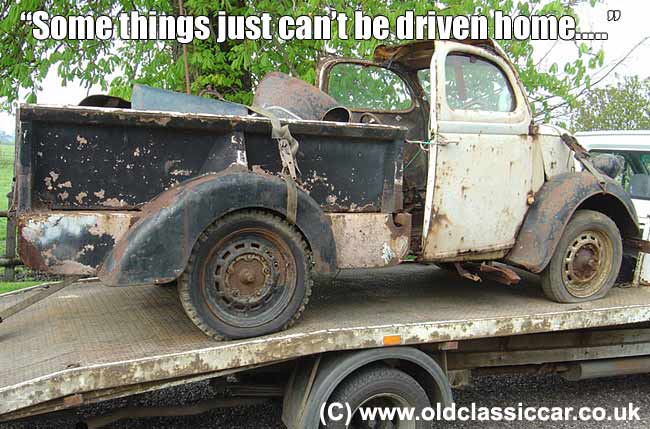
|





